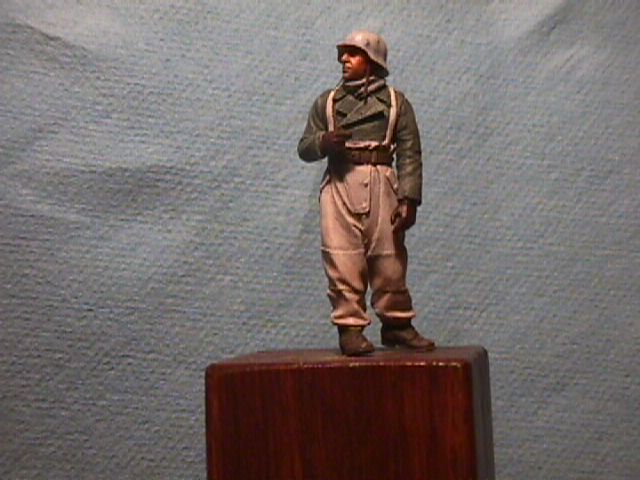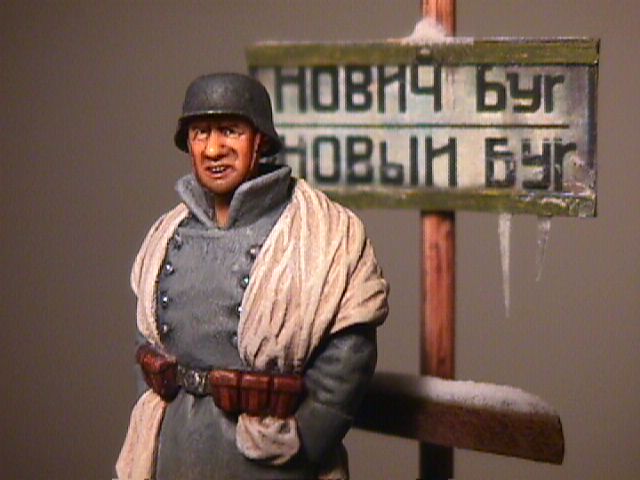

Painting Whites
Mark Bannerman

Two summers ago, I had an opportunity to attend my first big model show in Toronto. As I examined the figure in the display room, I noted the tremendous use of white colours on figures by the great Masters such as Bill Horan, Don Weeks, Phil Kessling, and Mike Good. I have followed these guys for several years through magazine articles. Seeing their figures in the flesh was really impressive. On examining their figures, there was absolutely no evidence of any pure white whatsoever. In fact, this can be said about black as well ! I was a little stunned and decided to start asking questions.
I had an opportunity to corner Mike Blank, a Swedish figure painter who is undisputably one the masters when it comes to the treatment of whites. I asked the question straight out how he approached painting white. After a twenty minute explanation, I was convinced I would never try to paint white clothing. Admittedly, his results are absolutely stunning but blending 28 tones of white just seemed way beyond my abilities - and patience !
It was really necessary for me to understand how to paint whites. And while whites is nota commmon colour for the WWII figure buffs, it is absolutely crucial for the napoleonic types. I sat down a few weeks ago and tried to figure out a technique that was neither complicated and easy to duplicate. This is a technique described in the November 1991 issue of Military Modelling by Derek Hansen. I will share how I approached his technique with slight variations on a white bed sheet draped over a 1/35th scale Hornet figure.
After the usual clean up, and priming, I applied a light coat of Humbrol enamel white to the entire figure. Once dry, it was time to tackle the white sheet. I sprayed two thin cotes of Tamiya Gloss to ensure the undercoat is protected by the subsequent use of thinners and oils. On the figures bed sheet, I laid a base coat of light grey oil paints using Titanium White, Burnt Umber and a very tiny spec of Prussian Blue. This latter colour is very strong and the spec should be the size of a typed period. I took a thick brush and stroked upwards to deposit the oils into recesses and shadow areas. Continuously stroke until the highlights are back to the original white colours and all shadows are a taupe colour.
After the oils had dried, I applied Humbrol white to all the highlight areas. Let this dry and apply Titanium white to the highlight areas over the Humbrol White highlights. Let this sit for several days to thoroughly. Now you have two distinct colours - shadows in a murky off-white brownish colour and very white highlights. The next step is the crucial step. Once thoroughly, I applied a coat of Titanium White colour over the entire sheet including the previously painted shadows. I immediately removed the oil paint leaving a glaze-like film on the bed sheet. This essentially does two things - lightens the bed sheet and blends highlights and shadows together. Once dry, the last step was to apply some shadows in the very deep recesses using the shadow mix of Titanium, White, Burnt Umber and a spec of Prussian Blue.
The rest of the figure in brief: The jacket took a base of Humbrol 67 mixed with
Humbrol White, shadows mixed with Paynes Grey oils and Humbrol 67, and highlighted
in Humbrol light grey. The straps were painted in Mars Black oil and lightly drybrushed
with Humbrol 93. The pouches were painted Humbrol White, stained with Burnt Sienna and
drybrushed with Burnt Umber oils. Semi-Glossed after drying. Boots were painted Humbrol
white, Mars Black mixed with Burnt Umber. Buttons and
buckle painted Black, and highlighted with Silver. Gloss coated when dry. The head is a
Warriors offering painted in my usual
manner.
When I completed the figure it looked suspiciously boring. I decided this fellows
needed some dirt and grime as he was supposed to be in the depths of Russia. I pulled out
every brown coloured Humbrols I had and started to poke the figure`s lower jacket with an
old dried up brush using Humbrol 29, 84, 72, and 110. Think of this step as a dry-brushing
treatment, but rather than stroking, use a poking action. I repeated the steps adding
Humbrol white to the browns. I must have poked the figure 1000 times! Caution - if it does
not look like enough dirt, it probably is enough dirt! It is easy to go overboard with
this. If you feel you have applied too much dirt and grime, lightly dry brush with the
grey base colour and this will help tone it down.
That wraps up another fun project. If any of you have suggestions, comments or another
method of dealing with whites (or anything I have mentioned above), I would certainly
appreciate hearing from you.

| Main | What's New | Articles | Reviews | Gallery | Think Tank | Contests |